Amid the fecundity happening at weedom, there’s an urgent need to touch base with you. That’s because the lemon balm must be harvested promptly before it has all gone to flower. Certain of the useful properties of this well known herb are at their strongest and best, early in the lifecycle, and fresh is best.
If you don’t think you have any lemon balm, check again. Unless you’re pretty remote, there’s a decent chance this species of mint, Melissa officinalis, has been dropped into your world by a passing animal or bird, or spread from a neighbor’s garden. Though native to such places as Southern Europe, it is naturalized to North America, likely by the settlers from Europe. Both perennial and copiously self seeding, lemon balm is a true weed, most prominent in USDA hardiness zones 3a through 7b, but not exclusive to these. You possibly have in your possession this well studied and documented medicinal power house, which is both tasty and a veritable panacea. Don’t pass it up!
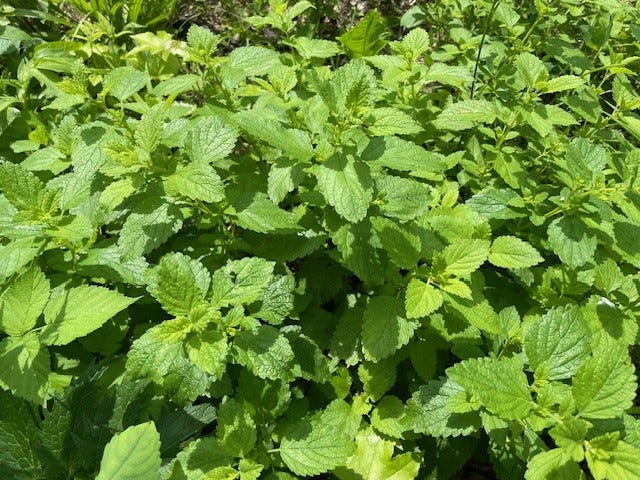
Let’s make sure everyone can find the lemon balm. Start by paying attention to your nose as you travel through weedy edges of your gardens. Expect the biggest plants in partly shaded areas. Do you smell the tart citrus as you yank the overgrowth? Good chance it’s lemon balm. Look for these crenate toothed leaves which are ovate to spade shaped, and about 1-3 inches (2.5-7.5 cm) long and wide. From a central vein, the smaller leaf veins emerge in a pinnate pattern. Leaves are rough, somewhat wrinkled, with small spiky hairs projecting from the green top side. The undersides are a grey green, with none of these hairs.

Young plants are classically mintlike in form, with the square, hairless stems, and oppositely arranged leaves projecting north / south, alternating with east / west. As the plant matures, more stems emerge from leaf axils. Later, both flowers and stems emerge from the axils. Once this happens, the plant chemistry changes, and some, but not all of the useful properties remain. Another reason to go after lemon balm early is to avoid dealing with the leaf spot and some other fungal diseases that commonly affects this and many other mints growing in humid weather.
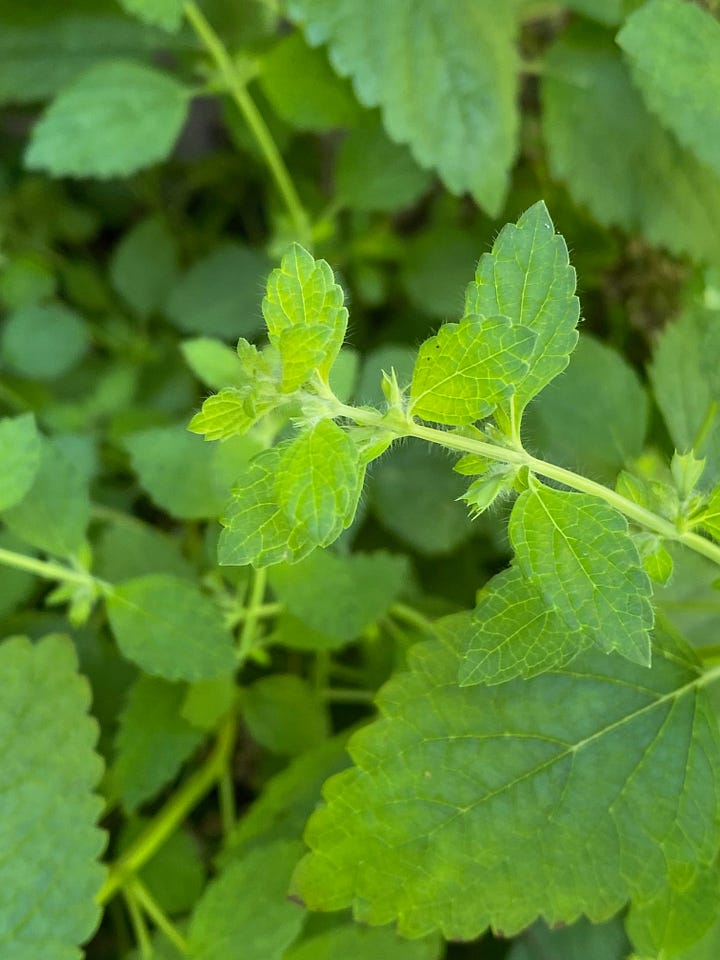
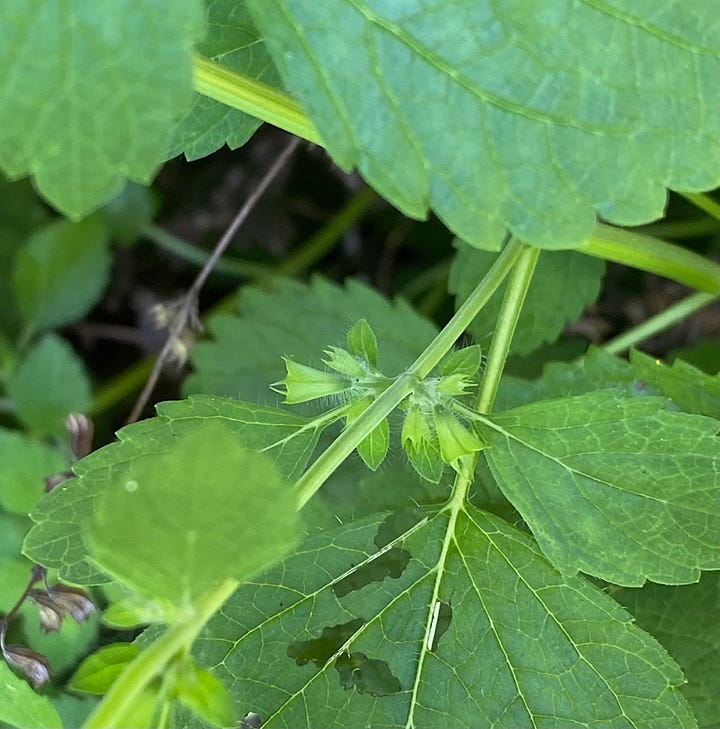
By earliest summer, the flowers exist in whorls around the leaf axils. They remain as inconspicuous, small white, 2 lipped, tubular flowers, largely encased in the prominent green sepals. Though small, there are plenty of these blooms, and bees will buzz all over them throughout summer and into fall. Finally these give way to zillions of capsular fruits, each bearing very tiny seeds. As the season wears on, stems transform from green to copper and then to a woody brown color. Lemon balm ‘skeletons’ remain throughout the winter, and around the base, new growth returns in the spring, along with many new seedlings. If the lemon balm is cut down vigorously after it flowers, it will very often produce new, harvestable growth of leaves. We frequently have been able to obtain some useful leaves in the late summer or fall.
Upon returning to weedom from a new type of familial duties, (as our subsequent generation has begun reproducing), it was immediately necessary to forge into the weeds and harvest lemon balm. Some fresh leaves went into a tincture of strong ethanol, (we chose 95%, though many herbalists will tincture dried lemon balm leaves in 45-60 percent ethanol.) The rest of the leaves were freeze dried for tea. The lemony citral and geranial derivitives in lemon balm tend to be quickly lost with significant heating and drying, so careful temperature and light control is recommended. Even with loss of flavor, however, many useful compounds remain in this herb. Lemon balm flavor is mild but useful for adding to many herbal teas, foods and formulations. But this evanescent citrus quality belies the well documented array of benefits this herb confers.
Lemon balm was known to ancient herbalists, and its use was recorded by Greeks, Hippocrates and Galen, and Roman Pliny. The genus name ‘Melissa’ derives from the Greek word for bee. The species name ‘officinalis’ attaches to many of the most recognized and respected medicinal plants. Throughout the intervening years, this herb had a prominent place in apothecaries and monasteries, and was extolled as a veritable panacea.
Possibly the most known function of lemon balm is as a sedative, antidepressant, or nervine. This weed has activity to inhibit acetylcholine esterase, leaving more acetylcholine available. It also inhibits GABA transferase, thus allowing increase of GABA, (gamma amino butyric acid), an inhibitory neurotransmitter in the central nervous system that contributes to sedation. There are studies in humans showing that lemon balm alone, or in combination with chamomile, or with valerian is able to address anxiety, heart palpitations, and sleeplessness. This sedative activity has been associated with hydroalcoholic extracts that do not contain the volatile oils (so you can obtain the calming effects even without the citrus flavor).
Anti viral properties have been attributed to citral, citronellal, rosemarinic acid, melitric acid A, and luteolin-7-glucoside-3’-glucuronide. Particularly the activity against Herpes simplex I and II is said to be most prominent in the fresh leaves picked in spring before flowering. Aqueous extracts and hydroalcoholic extracts of lemon balm appeared more potent against the viruses than single molecules to which the activity was attrbuted. Extracts containing a high amount of rosemarinic acid showed in vitro activity inhibiting plaque formation and protein synthesis of Enterovirus 71, one of the viruses responsible for hand foot and mouth disease. Monoterpenes, citral A and B in lemon balm essential oil were found to inhibit influenza virus replication. Combining the essential oil with oseltamivir was observed to potentiate the latter drug against H1N1 flu virus in cell culture.
Herbalists often report that rubbing a macerated plant topically on a bite or sting will bring quick relief, with lemon balm being one of particular effectiveness. The anti-inflammatory effects of rosemarinic acid and various flavonoids found in this plant are mediated by numerous mechanisms which occur both very early and late in the process. In early inflammation, production of histamine, serotonin, leukotrienes, and NO (nitric oxide), as well as increased blood vessel permeability occur. Later in the inflammatory process, TNF-α, cytokines IL-1β, IL-6 and IL-10 are released, and bradykinin, edema, and neutrophil infiltration increase. The various flavonoid and other phenolic compounds of lemon balm have been shown in animal and in vitro studies to address all of these early and late factors of inflammation that are responsible for the pain and swelling that we experience. Human trials have demonstrated positive effects of lemon balm for such conditions as psoriasis, pain following childbirth, PMS, and pain and itching of herpes lesions.
The greatest body of human clinical trials of lemon balm has been in the area of addressing anxiety, depression, and in the treatment of patients with dementia. Though the results and relative safety provide high incentive for people to keep this herb around, we won’t be covering this large body of evidence in this article. Of interest is a single case report of withdrawal issues in a male who had consumed up to 4 cups of lemon balm infusion for a few months. He discontinued abruptly and his anxiety symptoms led him to seek help at the emergency room. Was it withdrawal, or just a return of what he had been treating? We don’t know, but he was able to resolve these issues in about a week with a short course of clonazepam, which like lemon balm, is GABA-ergic. Lemonbalm itself has high amounts of rosemarinic acid and lesser quantities of the triterpenoids, oleanolic and ursolic acids. These inhibit the breakdown of GABA, an inhibitory neurotransmitter which allows relaxation, sedation, and reduced anxiety. Want some of these compounds in your life? Remember, they’re more available in the alcoholic extracts, tinctures, of lemon balm, but to a smaller extent can even be available in a hot water infusion.
With its bi-millenial history of use, Melissa officinalis has been established as one of the safest herbs. The yield of essential oils in the plant material is quite low, as is the case with the other mint family members which are used as food. Overdosing is extremely difficult using the plant material itself. It’s considered safe for kids, with various studies in infants producing no dangerous adverse results. Human studies show that lemon balm, in combination with fennel and chamomile, as well as a combination of lemon balm with chamomile and heat-killed lactobacillus acidophilus, significantly reduce the crying time (by more than half) in colicky babies. Many of the suggested dietary alterations to address colic in infants are not nearly so well supported. These herbal combinations could possibly preserve both sanity and lives.
We’ll be returning repeatedly to lemon balm in the future because it does so much more than mentioned here. See ‘Where We Dig’, below.
Keep scrolling to check out what’s the coolest at weedom:
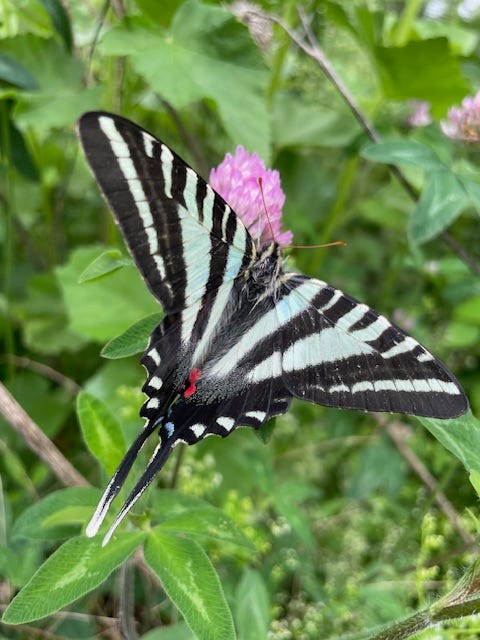
Ultra Bonus! #1 little dude emerged healthy after causing his mom significant travails. She is recovering quickly, and both she and hubby are fully engaged in the new, sleepless life of ‘parental units’ :-D
Where We Dig
1. Nadeem M, Imran M, Aslam Gondal T, et al. Therapeutic Potential of Rosmarinic Acid: A Comprehensive Review. Applied Sciences. 2019;9(15):3139. doi:10.3390/app9153139
2. Yargholi A, Shirbeigi L, Rahimi R, Mansouri P, Ayati MH. The effect of Melissa officinalis syrup on patients with mild to moderate psoriasis: a randomized, double-blind placebo-controlled clinical trial. BMC Research Notes. 2021;14(1):253. doi:10.1186/s13104-021-05667-9
3. Wood M. The Earthwise Herbal - A Complete Guide to Old World Medicinal Plants. North Atlantic Books; 2008. https://openlibrary.org/books/OL12031143M/The_Earthwise_Herbal
4. Cases J, Ibarra A, Feuillère N, Roller M, Sukkar SG. Pilot trial of Melissa officinalis L. leaf extract in the treatment of volunteers suffering from mild-to-moderate anxiety disorders and sleep disturbances. Med J Nutrition Metab. 2011;4(3):211-218. doi:10.1007/s12349-010-0045-4
5. Petrisor G, Motelica L, Craciun LN, Oprea OC, Ficai D, Ficai A. Melissa officinalis: Composition, Pharmacological Effects and Derived Release Systems-A Review. Int J Mol Sci. 2022;23(7):3591. doi:10.3390/ijms23073591
6. Juee LYM, Sofi SH, Adham AN. Melissa officinalis gastroprotective and antioxidant efficacy. Journal of Functional Foods. 2023;105:105550. doi:10.1016/j.jff.2023.105550
7. Melissa officinalis (Balm, Balm Mint, Common Balm, Lemon Balm) | North Carolina Extension Gardener Plant Toolbox. Accessed May 28, 2024. https://plants.ces.ncsu.edu/plants/melissa-officinalis/
8. Hoffmann D. Medical Herbalism: The Science and Practice of Herbal Medicine. Healing Arts Press; 2003.
9. Ganora L. Herbal Constituents, 2nd Edition - Foundations of Phytochemistry. Lulu Press, Inc.; 2021. https://openlibrary.org/books/OL35083771M/Herbal_Constituents_2nd_Edition
10. Cherry RN, Blanchard SS, Chogle A, Santucci NR, Mehta K, Russell AC. Herbal Approaches to Pediatric Functional Abdominal Pain. Children (Basel). 2022;9(8):1266. doi:10.3390/children9081266
11. Evans C, Lorentz WP. Efficacy and Safety of a Colic Relief Remedy in Infantile Colic. Glob Pediatr Health. 2022;9:2333794X221100810. doi:10.1177/2333794X221100810
12. Demirci K, Akgönül M, Demirdaş A, Akpınar A. Does Melissa Officinalis Cause Withdrawal or Dependence? Med Arch. 2015;69(1):60-61. doi:10.5455/medarh.2015.69.60-61
13. Awad R, Muhammad A, Durst T, Trudeau VL, Arnason JT. Bioassay-guided fractionation of lemon balm (Melissa officinalis L.) using an in vitro measure of GABA transaminase activity. Phytother Res. 2009;23(8):1075-1081. doi:10.1002/ptr.2712
14. Draginic N, Andjic M, Jeremic J, et al. Anti-inflammatory and Antioxidant Effects of Melissa officinalis Extracts: A Comparative Study. Iran J Pharm Res. 2022;21(1):e126561. doi:10.5812/ijpr-126561
15. Zam W, Quispe C, Sharifi-Rad J, et al. An Updated Review on The Properties of Melissa officinalis L.: Not Exclusively Anti-anxiety. Front Biosci (Schol Ed). 2022;14(2):16. doi:10.31083/j.fbs1402016
16. Gardner ZE, McGuffin M. American Herbal Products Association’s Botanical Safety Handbook. 2nd ed. CRC press; 2013.
17. Forêt R de la. Alchemy of Herbs: Transform Everyday Ingredients into Foods & Remedies That Heal. Hay House, Inc; 2017.
18. Savino F, Cresi F, Castagno E, Silvestro L, Oggero R. A randomized double-blind placebo-controlled trial of a standardized extract of Matricariae recutita, Foeniculum vulgare and Melissa officinalis (ColiMil) in the treatment of breastfed colicky infants. Phytother Res. 2005;19(4):335-340. doi:10.1002/ptr.1668







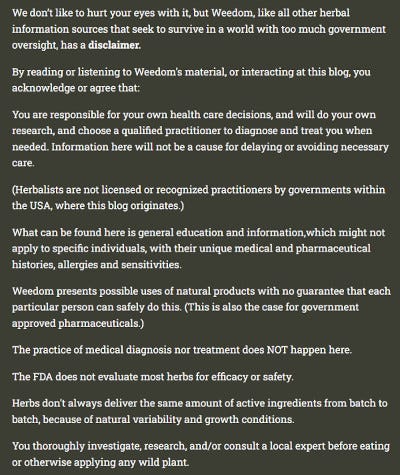
Beautiful baby. Congrats.
Thank you for the information on lemon balm.
I have been drying the weed and drinking the tea at night. It does increase the quality of sleep!
Congratulations on sweet baby!